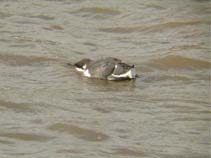Alca torda Linnaeus, 1758
Razorbill
Classification / Names Common names | Synonyms | CoL | ITIS | WoRMS
Aves | Charadriiformes | Alcidae
Environment: milieu / climate zone / depth range / distribution range Ecology
Others; depth range 0 - 120 m (Ref. 62202). Polar; 82°N - 27°N, 80°W - 43°E (Ref. 124582)
Distribution Countries | FAO areas | Ecosystems | Occurrences | Introductions
Northwest Atlantic, Eastern Atlantic and the Arctic: Polar to temperate.
Length at first maturity / Size / Weight / Age
Maturity: Lm ? range ? - ? cm Max length : 45.0 cm TL male/unsexed; (Ref. 8812); max. published weight: 719.00 g (Ref. 356)
Short description Morphology
Life cycle and mating behavior Maturity | Reproduction | Spawning | Eggs | Fecundity | Larvae
Main reference
References | Coordinator | Collaborators
Camphuysen, C.J.K. 1998 Razorbills Alca torda in Dutch waters. Limosa 71(2):69-77. (Ref. 7319)
IUCN Red List Status
(Ref. 130435: Version 2025-1)
CITES status (Ref. 108899)
CMS (Ref. 116361)
Threat to humans
Human uses
| FishSource |
Tools
More information
Max. ages / sizes
Length-weight rel.
Length-length rel.
Length-frequencies
Mass conversion
Abundance
Internet sources
BHL | BOLD Systems | CISTI | DiscoverLife | FAO(Publication : search) | Fishipedia | GenBank (genome, nucleotide) | GloBI | Gomexsi | Google Books | Google Scholar | Google | PubMed | Tree of Life | Wikipedia (Go, Search) | Zoological Record



